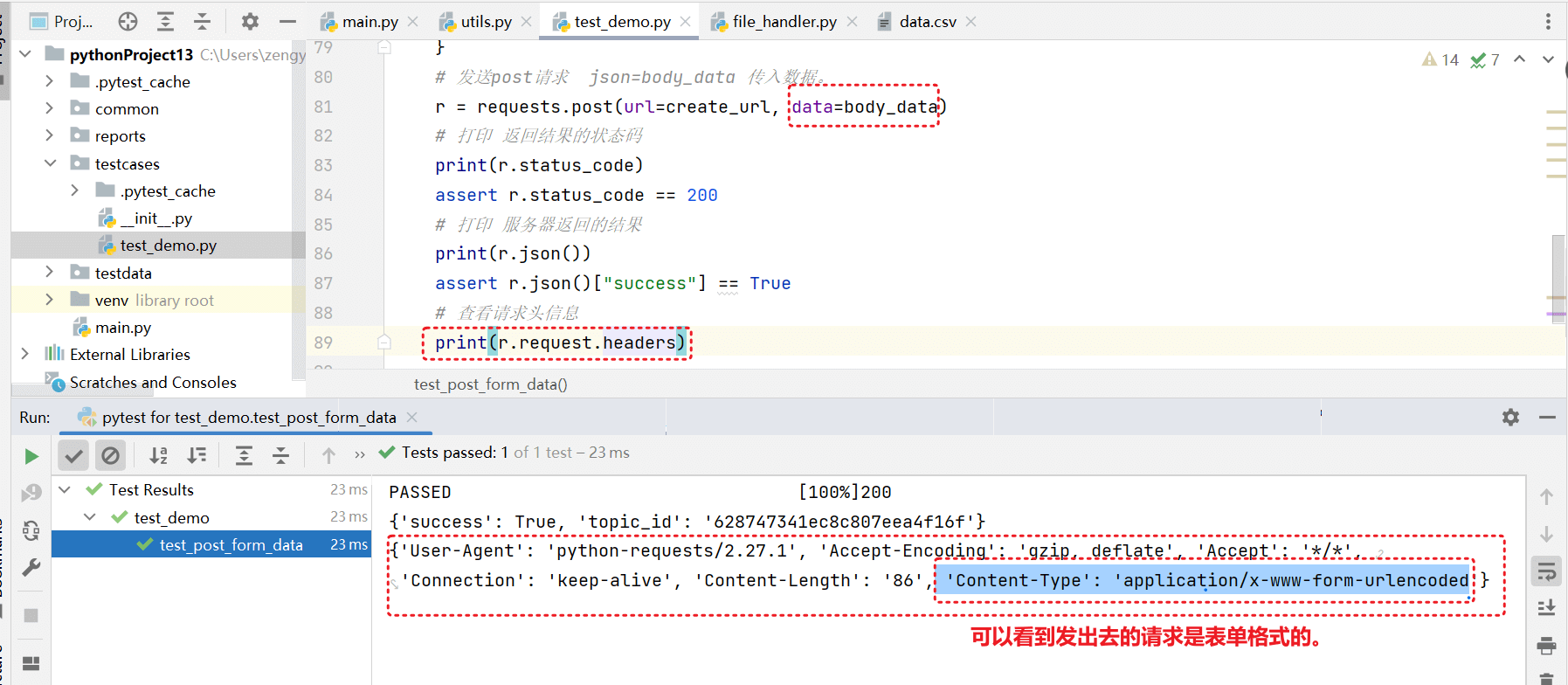基本使用
发送get 请求
使用 requests 库进行模拟发送请求。
所有的测试用例 函数名都以 test_ 开始
def test_home_topic():
# 请求的urlhome_url = "http://47.100.175.62:3000/api/v1/topics"# 发送get请求r = requests.get(url=home_url)# 打印 服务器返回状态码 status_codeprint(r.status_code)# 打印 服务器返回的结果print(r.json())
在pycharm 中执行。可以看到对应的效果。<br /><br />pycharm 正常情况下会自动识别 test_ 开头的函数名作为测试用例来执行。 如果你的pycharm 没有识别出来。
<a name="GI3aF"></a>
## 命令行运行
命令行使用pytest 命令来执行。<br />点击 【Terminal 命令行】<br />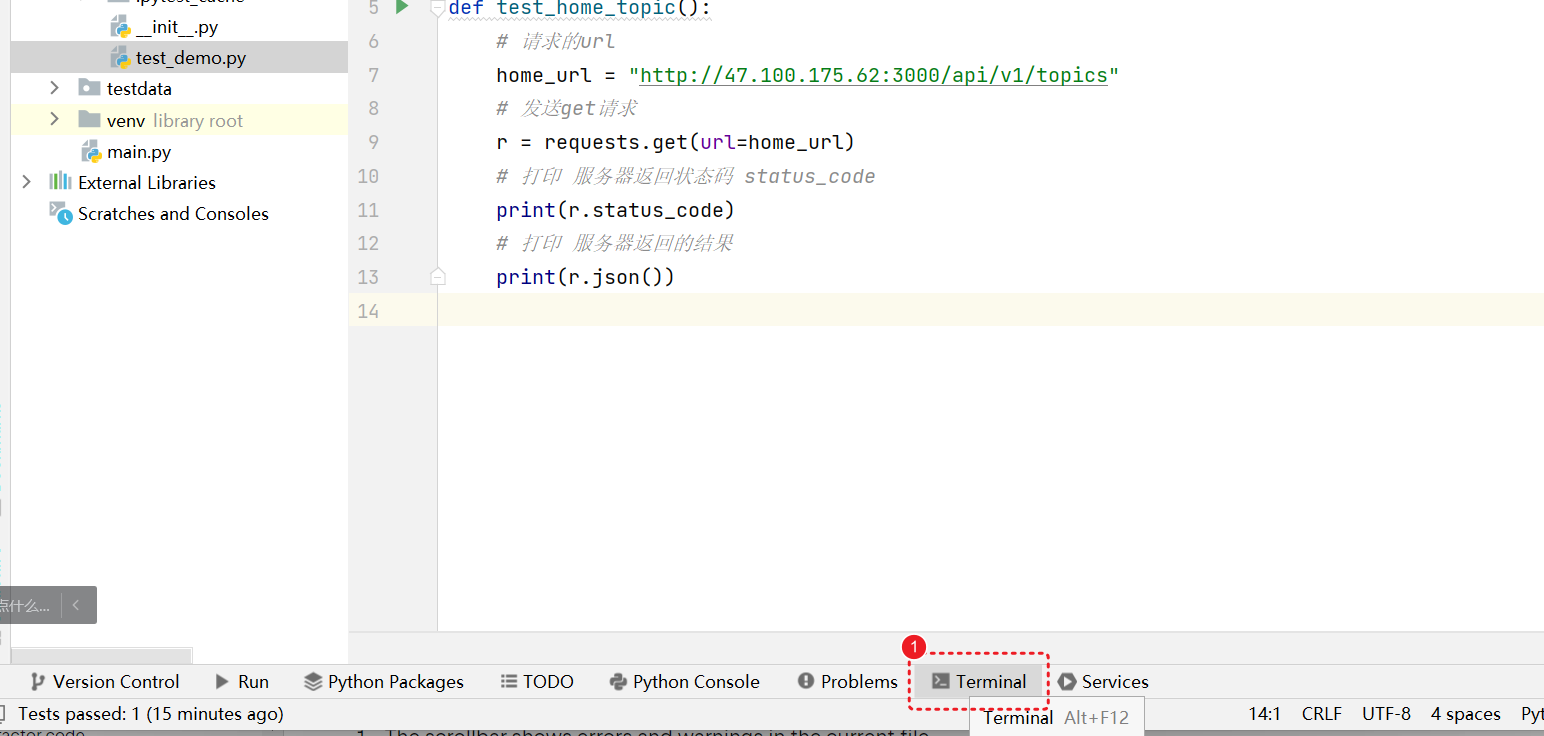
```python
pytest .\testcases\test_demo.py -s -v
- testcases\test_demo.py 文件路径
- -s 显示代码中打印的内容
- -v 日志的级别

执行之后,可以在pytest 中看到对应的执行结果。
在命令行中执行 和 在 pycharm 执行 最终的结果都是一样的。同学们可以根据自己喜好选择运行,能运行就可以了。
发送post请求
# 导入包
import requests
# 所有的测试用例 函数名都以 test_ 开始
def test_create_topic():
create_url = "http://47.100.175.62:3000/api/v1/topics"
body_data = {
"accesstoken":"e18de36f-d9ce-47e6-a2aa-1cf6508ec10b",
"title":"hell000o",
"tab":"ask",
"content":"123456"
}
# 发送post请求 json=body_data 传入数据。
r = requests.post(url=create_url,json=body_data)
# 打印 返回结果的状态码
print(r.status_code)
# 打印 服务器返回的结果
print(r.json())
get 请求参数
get请求有参数的时候,需要添加对应的请求参数。
# 导入包
import requests
def test_get_home_page():
homeurl = "http://47.100.175.62:3000/api/v1/topics"
querydata = {
"page":1,
"limit":1
}
# 发送get请求, params表示请求的参数
resp = requests.get(url=homeurl,params=querydata)
# 断言 状态码为 200
assert resp.status_code == 200
# 打印 服务器返回结果
print(resp.json())
# 断言 服务器返回结果只有1条数据
添加请求参数。
定义请求数据为字典格式。
querydata = { "page":1, "limit":1 }在get() 函数中传参 params=querydata
- assert resp.status_code == 200 添加状态码断言
断言练习
def test_get_home_page2():
homeurl = "http://47.100.175.62:3000/api/v1/topics"
querydata = {
"page": 1,
"limit": 20,
"tab": "ask"
}
# 发送get请求, params表示请求的参数
resp = requests.get(url=homeurl, params=querydata)
# 断言 状态码为 200
assert resp.status_code == 200
# 打印 服务器返回结果
print(resp.json())
# 添加断言 服务器会返回20条数据
alltopics = resp.json()["data"]
assert len(alltopics) == 20
# 添加断言 返回的结果中 话题,20个话题,每个话题的 tab 值都是 ask
# 循环列表,获取每个话题
for topic in alltopics:
# 打印
print(topic["tab"])
# 进行断言
assert topic["tab"] == "ask"
post请求两种数据格式:表单格式、json格式
发送表单格式
数据类型选择 x-www-form-urlencoded 的时候 ,数据类型为表单格式。
python中发送表单格式,在post 请求中将值传递给 data.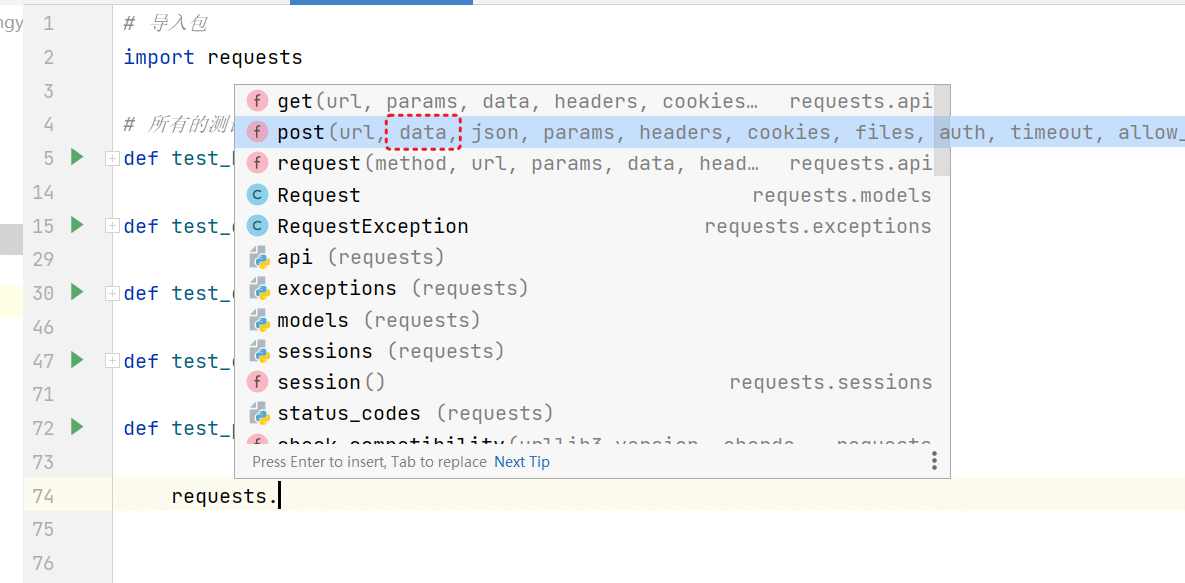 发送表单数据。
发送表单数据。
def test_post_form_data():
create_url = "http://47.100.175.62:3000/api/v1/topics"
body_data = {
"accesstoken": "e18de36f-d9ce-47e6-a2aa-1cf6508ec10b",
"title": "hell000o",
"tab": "ask",
"content": "123456"
}
# 发送post请求 json=body_data 传入数据。
r = requests.post(url=create_url, data=body_data)
# 打印 返回结果的状态码
print(r.status_code)
assert r.status_code == 200
# 打印 服务器返回的结果
print(r.json())
assert r.json()["success"] == True
# 查看请求头信息
print(r.request.headers)
发送json格式
如果发送的请求数据格式为json, 那么我们就将数据传递给json.

对应的代码。
import requests
def test_post_json():
create_url = "http://47.100.175.62:3000/api/v1/topics"
body_data = {
"accesstoken": "e18de36f-d9ce-47e6-a2aa-1cf6508ec10b",
"title": "hell000o",
"tab": "ask",
"content": "123456"
}
# 发送post请求 json=body_data 传入数据。
r = requests.post(url=create_url, json=body_data)
# 打印 返回结果的状态码
print(r.status_code)
assert r.status_code == 200
# 打印 服务器返回的结果
print(r.json())
assert r.json()["success"] == True
# 查看请求头信息
print(r.request.headers)
可以看到结果, 请求使用的数据格式为json 格式。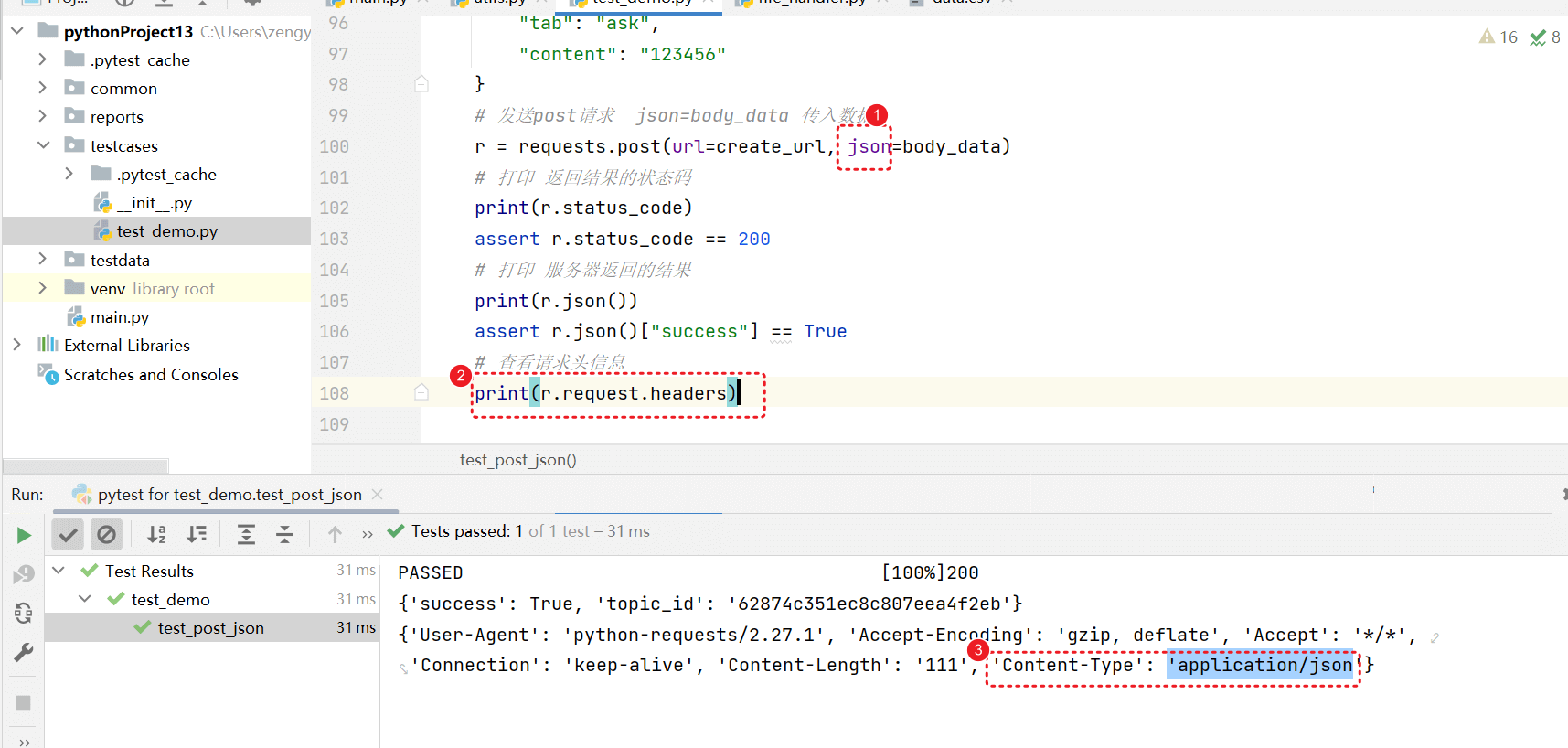
对于我们编写测试用例的时候,接口使用 表单格式还是使用 json 格式。取决于公司的开发,根据开发的定义,选择对应的格式。
发送带有信息头headers 的请求
新建一个文件, testcases/test_shopping.py 编写新丰商城接口
"""
接口地址: http://49.233.108.117:28019/swagger-ui.html#/
"""
import requests
base_url = "http://49.233.108.117:28019"
def test_register():
"""
测试注册用户
:return:
"""
register_url = base_url+"/api/v1/user/register"
jsondata = {
"loginName": "13310001229",
"password": "123456"
}
# 发送json格式数据
r = requests.post(url=register_url,json=jsondata)
# 打印状态码
print(r.status_code)
# 打印返回结果
print(r.json())
# 添加对应的断言
assert r.status_code == 200
assert r.json()["message"] == 'SUCCESS'
def test_login():
"""
测试登录
:return:
"""
login_url = base_url+"/api/v1/user/login"
login_data = {
"loginName": "13310001229",
"passwordMd5": "E10ADC3949BA59ABBE56E057F20F883E"
}
r = requests.post(url=login_url,json=login_data)
print(r.status_code)
print(r.json())
现在可以进行注册登录。但是有个问题, 注册的账号 每次都要手动修改。
GET请求带有信息头
根据接口文档,接口文档中 header 表示信息头。 在做这个接口的时候,需要将token值放在信息头中。
将token放在信息头中。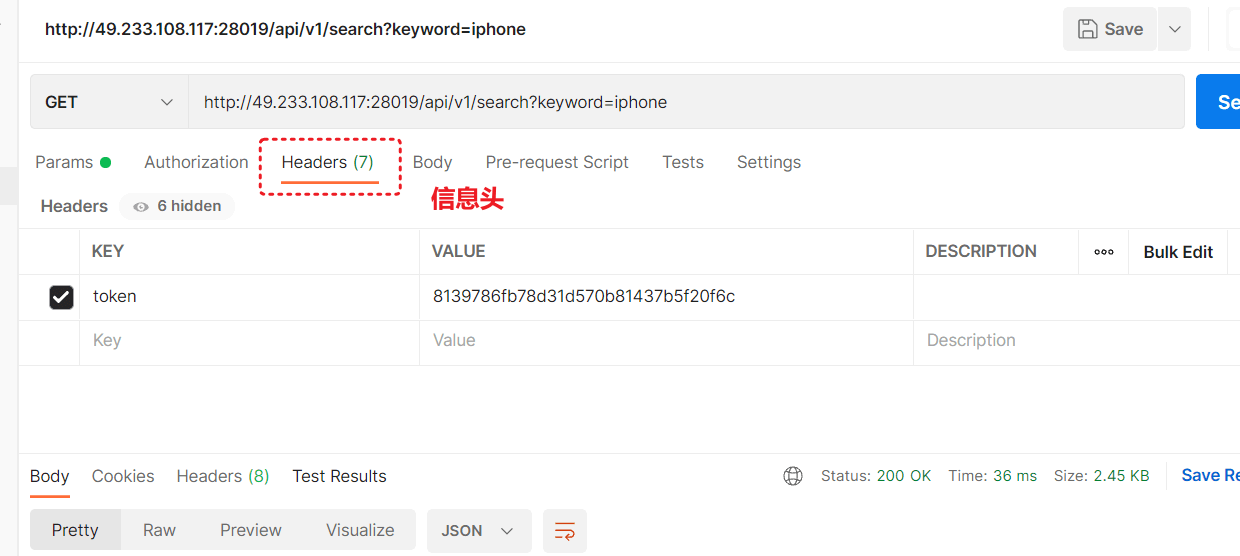
在发送请求的时候,将 token放在信息头中,发送。
使用 python requests 来实现。
import requests
def test_search():
search_url = base_url+"/api/v1/search"
# 定义信息头
header_data ={
"token":"8139786fb78d31d570b81437b5f20f6c"
}
# 请求参数
query_data={
"keyword":"iphone"
}
# 发送get请求 params 请求参数, headers 信息头
r = requests.get(url=search_url,params=query_data,headers=header_data)
# 状态码
print(r.status_code)
# 返回结果
print(r.json())
print(r.request.headers)
可以看到对应的请求头信息
- headers= 请求头部分
Post请求带有信息头
post请求和get请求中的信息头 是一样的用法。
也是将数据传递给 headers
import requests
base_url = "http://49.233.108.117:28019"
def test_add_cart():
add_cart_url = base_url+"/api/v1/shop-cart"
header_data = {
"token":"429054b175e70c0510e55ddaecf5995b",
}
post_data = {
"goodsCount": 1,
"goodsId": 10278
}
# 发送post请求
r = requests.post(url=add_cart_url,headers=header_data,json=post_data)
print(r.status_code)
print(r.json())
# 查看信息头 ,请求body 数据 r.request.body
print(r.request.headers,r.request.body)
不管是 是get 还是 post ,或者 put 这些方法,传入信息头时 值都传给 headers。

